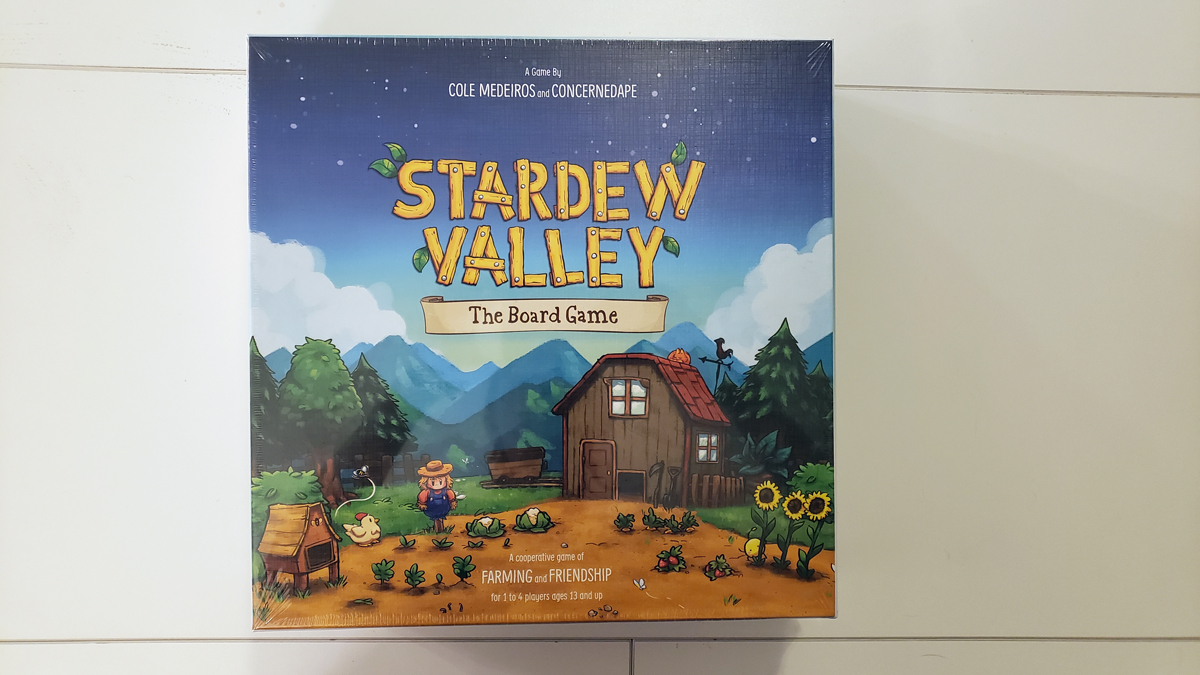Stardew Valley is an absolute favorite game of mine. I’ve spent hours building up a farm, harvesting crops, raising animals, exploring mines, foraging, and fishing. It’s simple and calm, which is great for my anxiety, but there’s also so much to explore and do that you can always find something to work on. I first played Stardew Valley on the PC, but we have copies for the iPad and the Switch too. When I found out that Cole Medeiros was developing a board game adaption with Stardew Valley creator CorncernedApe, I was immediately curious. A preliminary peek at the rulebook had me floored at just how many features of the game had been brought to the tabletop. I received a copy of Stardew Valley: The Board Game for reviewing.
What is Stardew Valley: The Board Game?
Stardew Valley: The Board Game is a cooperative game of farming and friendship based off of the extremely popular PC and console game. It is designed for 1 to 4 players, ages 13+, and takes about 45 minutes per player to play. It retails for an MSRP of $55.
Stardew Valley: The Board Game Components
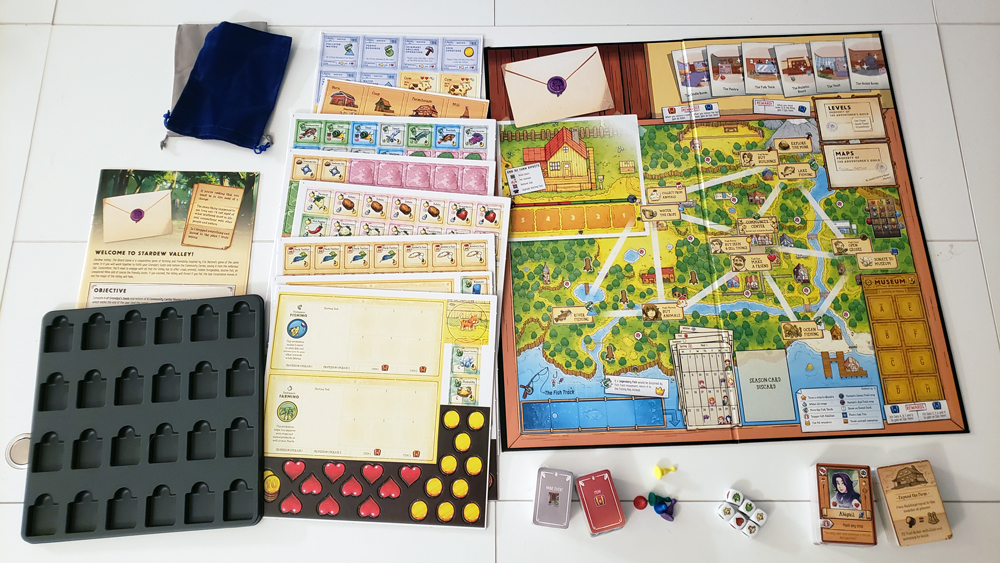
Stardew Valley: The Board Game is a very component-heavy game and I will suggest that, before playing, you factor in some time to punch out and sort components. The Supply items have their own tray, but others will likely need their own bags or rubber bands when putting away to make it easier to sort them out for your next game. Stardew Valley: The Board Game contains the following:
- Game Board
- Rulebook
- Player Pawns
- Spouse Pawn
- Stardew Dice
- Animal Dice
- Player Mats
- Starting Took Decks
- Gold Tokens
- Heart Tokens
- Villager Cards
- Season Cards
- Mine Level Cards
- Map Cards
- Goal Cards
- Building Tiles
- Animal Tiles
- Bundle Cards
- Professional Upgrade Cards
- Item Cards
- Epic Item Cards
- Event Cards
- Mine Event Cards
- Joja Tiles
- Tile Tray
- Crop Tiles
- Animal Resource Tiles
- Ore/Geode Tiles
- Stone Tiles
- Bug Meat Tiles
- Foragable and Tree Tiles
- Artifact/Mineral Bag
- Artifact & Mineral Tiles
- Fishing Bag
- Fish Tiles
It’s a significant list of components, but my first reaction at seeing everything was the delight at how much the artwork was pulled from the original game. The more you look at the components, the setup, and the gameplay, the more you see that this game is a real labor of love by someone who loves the original game and not someone who is just slapping a license on something to make it sell better.
The board is large, beautiful, and certainly sturdy. It recreates the oh-so-familiar map Stardew Valley fans should easily recognize and adds in convenient places to sort a number of the tokens and cards to help organize gameplay.
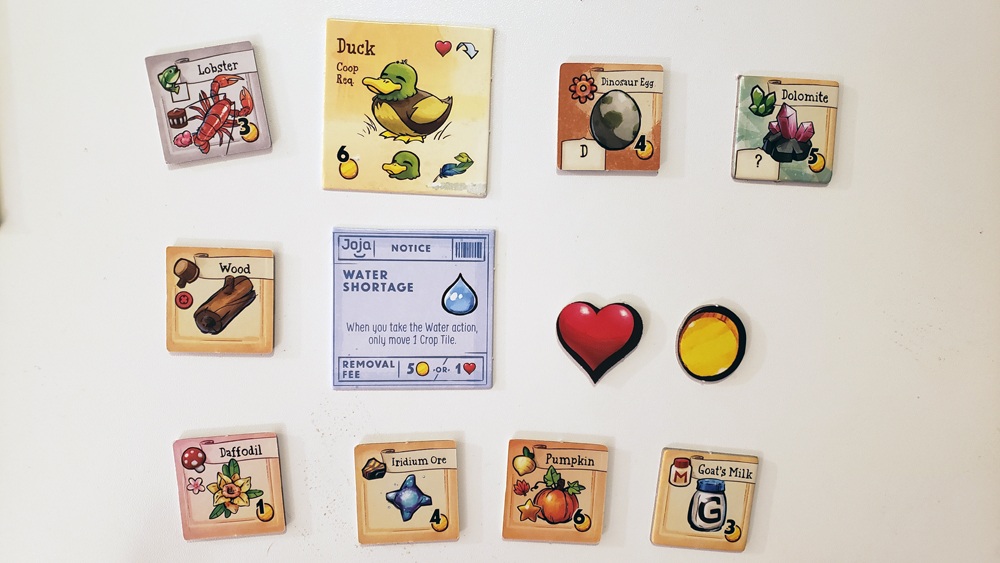
The Tiles, Tokens, and Player Mats are a sturdy thick cardboard and boast the same level of beautiful artwork as the board. Many of the tiles will either be placed in one of the bags (think beginner dice bag) or the very useful plastic Tile Tray, which probably saved my sanity. I wish there had been a second tray like that for putting away the other pieces and cards because that Tile Tray made things so nice and easy for me.
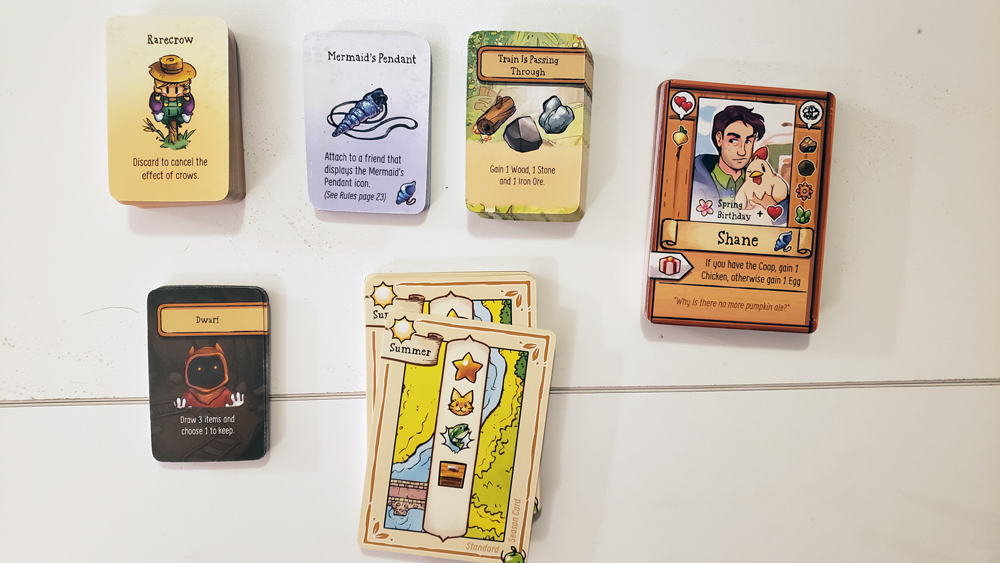
The Cards again use the same delightful game-inspired artwork as the other pieces but use design, size, and color to clearly help differentiate between the different types of cards that players will encounter.
The Pawns are a lightweight plastic but easy to tell apart by color, and the dice have delightful pictures on the side which allows them to have numerous uses during the game.
The Rulebook has a lot of really helpful diagrams and tables that make it an absolute asset during gameplay.
Overall, I’m a fan of the components and their quality. They line right up with what I would expect from a game that has an MSRP of $55 and I love the attention to detail in the artwork.
How to Play Stardew Valley: The Board Game
Setup
I will admit, this is a game that takes some time to set up, especially the first time you play because there are a lot of Tokens and Tiles to punch out and organize. That being said, the Rulebook does do a really nice job of streamlining the setup process. Players should also note that the Rulebook contains suggestions on adjusting the Difficulty Setting and Game Length. After setting things up, we choose to play the game on “Seedling” which is great for learning the game and sets a win condition of “Complete 4 of Grandpa’s Goals Only.”

Complete the following steps to setup your game:
- Set the Board in the middle of the play area. Place the Dice and the Spouse Pawn next to the Board. Shuffle the decks for the Joja Tiles, Villagers, Items, Epic Items, Events, and Mine Events Separately and set each Deck next to the Board.
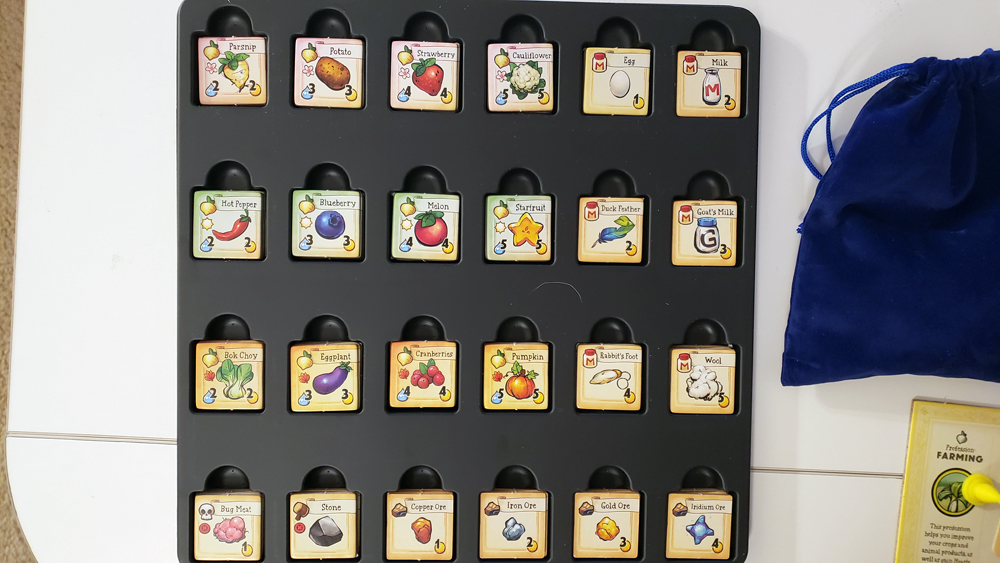
The Tile Tray is super useful. Photo by Elizabeth MacAndrew. - Place The Tile Tray near the Board and sort out the Supply Items in their places (a chart is provided). Then put the Fish tiles in the Blue Bag and the Artifact & Mineral Tiles into the Gray Bag. Set these items close enough for Players to access.
- Plant the first crop by taking a Parsnip Tile and placing it with the Star or Quality Side down on the 2nd Field Slot.
- Place Foragables by mixing the 11 Spring Tiles and randomly placing them over each Mushroom Icon. The 4 Spring Tree Tiles go Leaf Side up on the Tree Stump Icons. Sort the Foragable Tiles for the other Seasons and set them aside for later.
- Discover the in-season fish by pulling 5 Fish Tiles blindly from the Blue Bag. Fill the Fishing Slots starting with the rightmost empty slot.
- Set up the Mine Deck so that the Levels are in order with Level 1 being at the top and Level 12 at the bottom. Place the stack on the designated space on the Board. Beneath this you will place a Map Card. Shuffle the Map Cards and draw 1 Map Card, placing it face up beneath the Level Cards.
- Build the Season Deck and Place it face-down in the Season Space on the Board. Shuffle the Cards for Each Season and place each set on top of its Season End Card. Stack them with Spring First, then Summer, Fall, and Winter. Some gameplay versions may ask you to only use certain Season Cards in your Deck.
- For Each Community Center Room, randomly draw a Bundle Card and place it face-down on that room. Set the remaining Cards aside.
- Shuffle the Goal Deck and draw 4 Cards to place on the Letter on the Board. These are Grandpa’s Goals for your gameplay.
- Sort the Animal Tiles by Coop (Duck, Chicken, and Rabbit) or Barn (Cow, Sheep, Goat). The Coop Building Tile goes on top of the Coop Animals and the Barn Building Tile on top of the Barn Animals. Randomly draw two other Building Tiles to place beside these and return the rest to the Box.
- Each Player gets a Player Mat to determine Profession and gets a matching colored Pawn. Then each Player selects a Starting Tool Deck and Places it on their Player Mat with the Level 0 face-up on top.
- Players get 3 Gold to start gameplay. The Starting Player (whoever suggested gameplay) gets the Pet Token and the group decides if they have a Cat or a Dog.
Your game is now ready to play!
Gameplay
Each game round has three phases, although there will be lots of actions and choices during these Phases. Your first time playing may go slower and result in longer than estimated gameplay time, especially as you find yourself looking up symbols or rechecking rules on different Actions. The game does get faster as you get more familiar with everything though.
Season Phase

Draw a Season Card and carry out its instructions. Each Season Card has a series of icons that match a diagram. Festivals have a single effect and Season End cards have a series of events. For regular cards carry out the instructions top to bottom. Cards can include any of these effects:
- Quality Crop: Flip a plant so that it’s Quality side is showing.
- Rain: All Plants move 1 spot to the right. Any Plants that come off the Track go to the Starting Player.
- Fish Move: Discard the 2 rightmost Fish (Legendary Fish go back in the bag, any others are discarded), Move the remaining Fish to the right and then draw two new Fish Tiles to place.
- Gift: Each Player chooses 1 of their befriended Villagers and activates their Gift Ability. Then the effect of any non-villager Gift Cards happen.
- The Pet Wanders: The Starting Player passes the Pet Token to the Player to the left and they are now the Starting Player.
- Green Crow: 1 Crop from the Green Field is discarded.
- Red Crow: 1 Crop from the Red Field is discarded.
- Event: Draw an Event Card and resolve its effects.
- Joja: Draw a Joja Tile and put it on the corresponding Board space.
- Shipping Bin: Players may trade and sell resources.
At the end of a Season, Players will be asked to trade out Foragables and to draw 2 Profession Cards, keeping one and discarding the other.
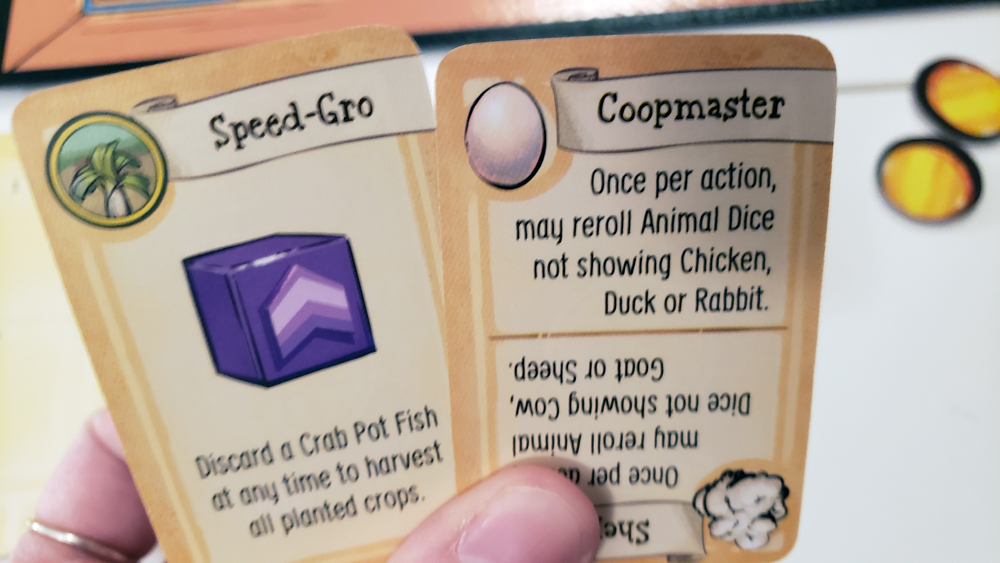
Planning Phase
Players trade Item Cards or Resource Tiles during this Phase as well as place their Pawn onto any Location. The Action phase comes next.
Action Phase
Players take actions at this point with the Starting Player going first and play moving clockwise. A Player may take 2 Actions in their Current Location or Take an Action, Move, and Take Another Action. When Players move along a path they make claim an available Foragable that they pass. If they get a Worm, they draw from the Artifact & Mineral Bag. If the Worm has a Mineral Icon, the Tile they draw goes Mineral side up. If the Worm has an Artifact Icon, the Tile drawn goes Artifact side up.
Here’s a breakdown of the action options:
- Water Crops (Farm Action): Spend an action to move all planted Crops one space to the right. If a Crop moves off Track, it is yours as long as you have Inventory space on your Player Mat, otherwise discard an item to make room or discard the Crop.
- Collect from Animals: (Farm Action): Spend 1 Action to roll 3 Animal Dice. If the results match Animals you have, you get one Resource for each matching die. Happy Animals generate a High Quality Resource.
- Buy Animals (Ranch Action): Spend an Action to visit Marnie and buy Animals. You may buy as many Animals as your Gold can cover, but you must have their appropriate Building.
- Buy and Plant Seeds (Town Action): Spend an Action to go to Pierre’s where you may sell Resources or buy Seeds. You can only buy Seeds for the current Season. The number next to the Water Drop tells you which field they go in. You may buy and plant multiple Seeds, but you may not stack them on the same Field Space.
- Make a Friend (Town Action): Reveal the top card from the Villagers Cards. If you can give them an item that befriends them, discard that Item from your Inventory and take the Villager Card. Collect the appropriate number of Hearts based on how good a Gift you gave. If you do not have an appropriate Gift, discard the Villager Card.
- Reveal and Donate to bundles (Town Action): Spend 1 Action to visit the Community Center where you may reveal Bundles or donate as much as you can. Revealing a Bundle costs Heart Tokens equal to the number of Players. You can use Hearts to Replace a Revealed Bundle as well. Donated Items are placed on he Bundle until completed. Once completed, discard Resources or return to the Supply Tray and remove the Bundle Card.
- Open Geodes (Forge Action): Spend 1 Action to have Clint open any Geodes you possess. Roll a Stardew Die and consult the Chart to show what your Geode gave you.
- Donate to Museum (Forge Action): Spend an action to Donate any Artifacts or Minerals you may possess to the Museum. Each Artifact or Mineral has a letter on its tile letting you know what Slot it can go in. Each slot may only hold 1 Item.
- Buy Buildings (Mountain Action): Spend 1 Action to go to Robin and have her build as many Buildings as you have Materials to purchase.
- Explore the Mine (Mountain Action): Go to the Mine and explore. Roll two Stardew Dice and then match the results to the Map Card to see what prizes you win. You may decide which die is the column die and which is the row die after rolling. If you encounter a monster, the Skull on the Level Card tells you what Effect happens. The Level Card also tells you what Ore and Geode choices are available.
- Fishing (Forest/Beach/Mountain): There are three places you can choose to go fish. Roll the Stardew Dice and match the dice with the requirements of a Fish from that area. Each die can only be used towards one Fish, but catching multiple Fish is possible. If you catch a Fish, remove it from the Fish Track, move the remaining Fish to the right and draw a new Fish from the Bag. If there was a treasure chest to the immediate right of the Fish you caught, claim it and draw an Item Card. To catch Crab Pot Fish, spend Bug Meat. Legendary Fish are never discarded but are returned top the Fish Bag. If you failed to catch a Fish, you may claim a piece of Trash if one is available.
End-of-Turn Effects
After a Player finished their actions, they may do one of the following End-of-Turn choices as they return their Pawn to the Farmhouse:

- Build a Staircase: Discard a number of Stones equal to the number of Players. This causes the current Mine Level Card to be removed and a new Map Card is drawn to replace the current one.
- Pet Animals: Discard the number of Heart Tokens equal to the number of Hearts displayed on each owned Animal to flip it to its Happy side.
- Remove Joja: Discard 1 Heart Token or 5 Gold to remove a Joja Tile.
- Upgrade Starting Tool: Discard the Resources listed on your Starting Tool to advance it to the next level.
Game End
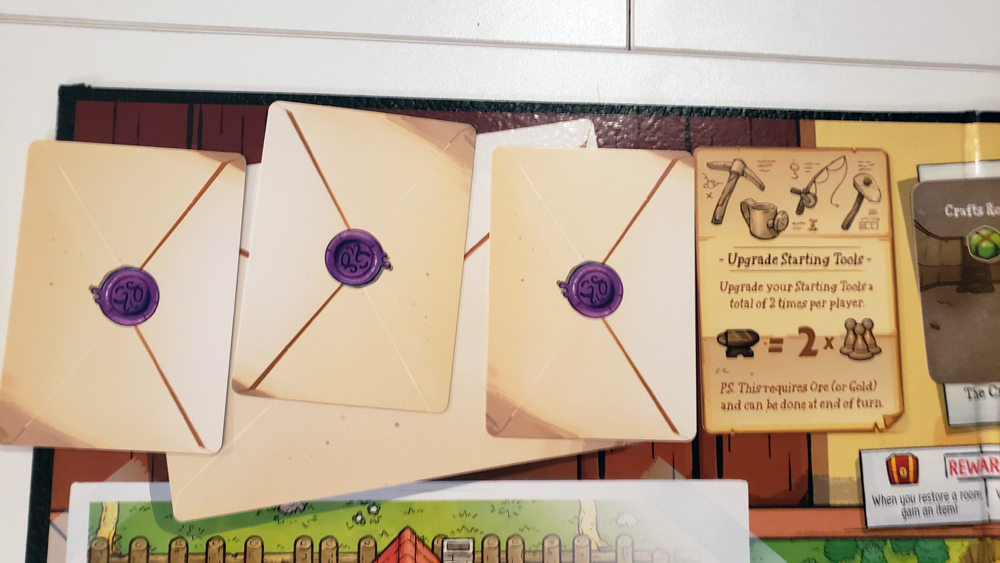
The Game Ends after the Season Cards reach the End of Winter Card. Whether or not the Players won depends on which Game Difficulty they played at and whether or not they met the conditions for that game.
- Seedling (recommended for beginners): Complete 4 of Grandpa’s Goals
- Honest Farmer: Complete 4 of Grandpa’s Goals and 1 Bundle per Room
- Artisan: Complete 4 of Grandpa’s Goals and 1 Bundle per Room with no Joja Tiles remaining on the Board.
The game difficulty can also be set by which Season Cards you use. When learning, it is recommended you use the Standard Season Cards (they are marked as such), but as you want your challenge to go up you may draw any 4 Cards for that Season to be used.
*Note: There are also additional rules for Solo Play available.
Why You Should Play Stardew Valley: The Board Game
Overall, this is a beautifully made game that is clearly a loving tribute to the PC/Console game on which it was based. It really is impressive just how much of the game got captured in board game form. Anyone who has already logged many hours playing Stardew Valley will love seeing so many game aspects they are familiar with and the artwork that they have come to love. Don’t be surprised if you find yourself wanting to log more time in to your farm immediately after playing the board game. At the same time, Players who have never played the original game will still find a game that they are able to catch onto and enjoy.
The game contains nicely made components that really do their job in covering a vast assortment of activities. Luckily they were also designed in a manner which helps to tell them all apart from each other to make gameplay run smoother. The Rulebook also contains some very useful charts and diagrams to help guide game play.
Setting up does take some work, as with any game with this amount of components. The process does streamline nicely and I feel like it will get faster as you play the game more.
Gameplay itself is broken down into a few simple steps with a number of choices you can take. That is where the real strategy for your team takes place. Having a wide variety of resources makes it much easier to befriend people and complete bundles, but you also have to decide if you want to concentrate enough to build up some Buildings and raise Animals, if you want to hit the deepest levels of the mines, or if gathering Artifacts and fishing are your thing. It’s a careful balancing act to accomplish, and your Goals from Grandpa will certainly play into this. There is a bit of luck involved as well. Between dice rolls and randomly drawn Fish, waiting for those Legendary Fish to pop can be hard (especially if you start off your game with a bunch of Trash and Treasure Chests in your Fishing Track). Luckily, the point of this game is cooperative play. True to the spirit of the original Stardew Valley, the board game isn’t about trying to beat out others. This is also another advantage for families. The game may list at ages 13+ and I agree in the sense I wouldn’t expect my ten-year-old to be able to run a game with other kids his age. However, do I think he can play the game with the adults and catch on enough since there isn’t a secrecy aspect to the game? Yes, I do. As long as you have a player or two who knows what they’re doing, you can fudge that age limit a little bit and make an evening of it. Just note, the game may run slower the first time you play at as there are a lot of choices and options you’ll be rechecking as you get a feel for things.
The game has an MSRP of $55, which is absolutely fair for a game this well thought out and detailed. The game can be purchased from the Stardew Valley Shop here. Currently, the game is listed as sold out but another wave of copies is in the works. Sign up for the newsletter at the bottom of the product page to be informed of when you can get a copy from the second batch. You can also follow @ConcernedApe on Twitter for updates.
